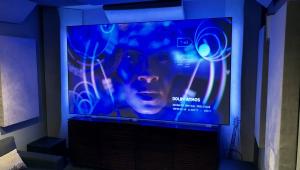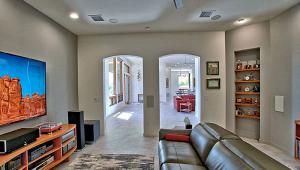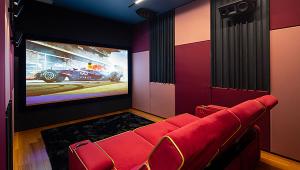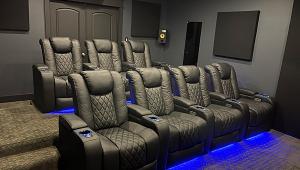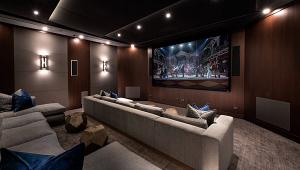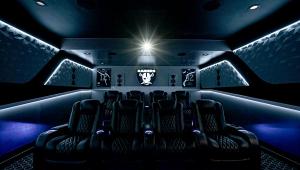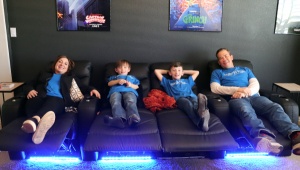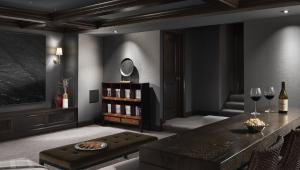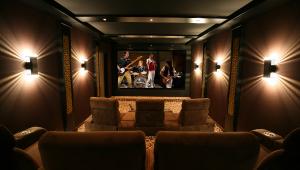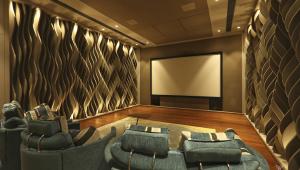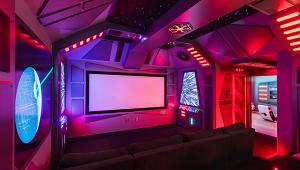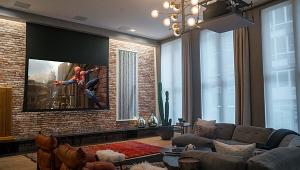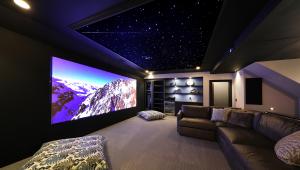Escaping 20,000 Leagues Under the Sea

Part of a larger remodel and home addition, I pushed out the walls of an existing bedroom to create an acoustically optimized 13 by 21 foot space. I used the bedroom closet for the AV equipment and media storage. The theater is adjacent to my home production office, so it also serves as a screening room for my work as a visual effects supervisor for films and television.

I worked out the design with 3D computer modeling, which allowed me to previsualize the space and view it from various vantage points. Full size drawings were printed out for the various elements I planned to build.
After the framing was completed, a second set of acoustically isolated walls and ceiling were built inside the structural shell. To minimize sound transmission from the theater to other areas of the house, I placed insulation between the double walls. Next was the construction of the stage and seating risers.
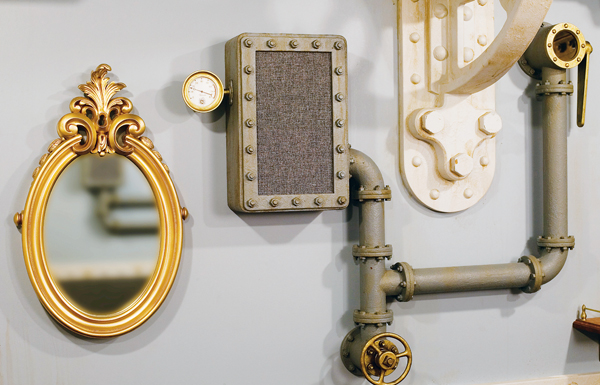
One of the most enjoyable parts of the project was fabricating the themed props and set dressing, allowing me to draw heavily on my experience as a modelbuilder and prop maker in the movie business. The first thing I built was the iconic iris viewport (behind theater seating) from the Salon of the Nautilus, where Captain Nemo would open the iris to view the underwater wonders of the sea. I cut the circular frame for the iris from layers of medium density fiberboard, which is often used in the construction of cabinets, including speaker enclosures. The finished viewport ring was then textured and painted to look like it had been cast in bronze. The iris blades were cut from a metallic grey countertop laminate. Everyone that visits the theater asks if the iris can open but, unfortunately, only drywall is behind it.
The round ductwork that was used, where the wall meets the ceiling, was made from sections of two-foot diameter heavy cardboard tubing commonly used for forming concrete pillars. These ducts also house the practical heating and air conditioning plenums for the theater.

The purely cosmetic ceiling beams were also cut from fiberboard, then textured and painted to look like iron. The beams were stiff enough that they only needed to be anchored to the walls, not the ceiling. The hundreds of rivet heads that adorn the beams and walls were cast from resin poured into rubber molds.
I built the 10-foot wide, curved projection screen using a finely perforated window blind material. Testing by folks in the do-it-yourself AV community has found this material to be acoustically transparent and perfectly suited for use as a projection screen. The curved framework for the screen was made from strips of wood, glued together using a curved form. The resulting frame was covered with black velvet and the window blind material attached.
The sound system for the theater was purchased long before the idea of a dedicated theater space had gelled and was originally intended for use in a multi-media family room. I selected the Thiel floorstanding speakers primarily for the outstanding sound but also for the superior fit and finish of the cabinets. Unfortunately these beautiful speakers are now hidden from view behind the acoustically transparent screen.

Additional elements include enclosures for the projector and surround speakers. Designed to look like the Magic Lantern, a Panasonic PT-AX200U projector is disguised as the forerunner of the movie projector from the late 1800s. The surround speakers appear to be mechanical equipment with faux iron pipes running to them. The enclosure is made of fiberboard and the pipes are PVC. Both were textured with sawdust and given several coats of paint. Other props include an intercom box, navigation gauges and Captain Nemo’s underwater rifle. A five-foot long model of the Nautilus, built by my friend Alan Haskell, sits on the stage beneath the screen, along with my Emmy as a visual effects artist.
This has been a total labor of love that is all the more worth the hard work when I see the joy on the faces of my family and friends as they sit back and imagine themselves aboard the Nautilus, joining Captain Nemo for an adventure 20,000 leagues under the sea.
Equipment List
Panasonic PT-AX200U projector
B&K AVR507 AV Receiver
B&K Reference 200.5 Amplifier
Front Left and Right Channel Speakers - Thiel CS2.4
Subwoofer – Cerwin Vega CLS-15S
Center Speaker - Thiel MCS
Surround Speakers - Thiel Powerplane 1.2
Panasonic DMP-BD35K BluRay Disc Player
Arcam DV78 DVD Player
Misubishi HS-U748 VCR
Hughes DirecTV HD Satillite Receiver
Monster HTS 5100 Mk2 Power Center
Transparent Audio In-Wall Speaker Cable
Logitech Harmony 550 Universal Remote
- Log in or register to post comments
